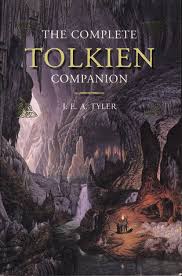 This is the second revision of The Tolkien Companion, originally written by J.E.A. Tyler and published in 1976. Tyler first updated The Tolkien Companion in 1979 — entitling it The New Tolkien Companion — after the posthumous publication of The Silmarillion in 1978 (Tolkien died in 1973) revealed a huge amount of hitherto unknown territory in Tolkien’s Middle-earth. The New Tolkien Companion added 1,800 entries to Tyler’s original work. This second revision, entitled The Complete Tolkien Companion, takes into account Christopher Tolkien’s work since 1979 on the twelve-volume History of Middle-earth, as well as another posthumous work by J.R.R. Tolkien himself, Unfinished Tales (1980).
This is the second revision of The Tolkien Companion, originally written by J.E.A. Tyler and published in 1976. Tyler first updated The Tolkien Companion in 1979 — entitling it The New Tolkien Companion — after the posthumous publication of The Silmarillion in 1978 (Tolkien died in 1973) revealed a huge amount of hitherto unknown territory in Tolkien’s Middle-earth. The New Tolkien Companion added 1,800 entries to Tyler’s original work. This second revision, entitled The Complete Tolkien Companion, takes into account Christopher Tolkien’s work since 1979 on the twelve-volume History of Middle-earth, as well as another posthumous work by J.R.R. Tolkien himself, Unfinished Tales (1980).
The book I hold in my hands is about five and a half inches wide, eight and half tall and one and a half thick. At over 700 pages, it handles like a nice, fat dictionary or thesaurus. As Jack Merry pointed out in his review of the original Tolkien Companion, a reference book of this size and seriousness works best as a hardcover. While I have the reviewer’s copy of this 2003 edition, which is a paperback, the book is available in hardcover, and I’d strongly recommend you go that route.
Thomas Dunne Books has used a thick, brilliant white paper for this edition. While it definitely makes the book far thicker and heavier than if they’d chosen thinner paper, I appreciate the choice for readability and durability over the long run, another valuable quality in a reference work. However, while the title page promises “illustrations by Kevin Reilly,” it’s somewhat deceptive, as the only illustrations are occasional maps and the illuminated letter at the beginning of each alphabetical section (nicely done, to be sure).
The book is laid out like an encyclopedia, with names and topics arranged alphabetically. Each entry is written in Tyler’s clear but poetic style, which makes them a pleasure to read. “On the far banks of both rivers,” I read in an entry picked at random, “lay the forests of Doriath and Brethil, silent and impenetrable.” Lovely! The entries range in length from a short line to several pages, depending on the complexity of the topic (and how much Tolkien loved it and developed it in his work). “Dwarves” gets over six pages, while “Dwarrowdelf” gets three lines.
Tyler is an author and journalist who is, in my opinion, one of the best authors of general “Tolkien guides” available today. While his scholarship may not be as extensive as that of some other authors, he has the ability to see the entire legendarium and its interlinking components, and to lay out and cross-reference those components with an understanding and clearness of text that makes his work easily accessible to readers, from the Tolkien neophyte to the Tolkien scholar. If you only have one reference book on Tolkien on your shelf, it ought to be this one. If you have many books on Tolkien, but not this one, you owe it to yourself to complete your collection with The Complete Tolkien Companion.
(Thomas Dunne Books, 2003)
